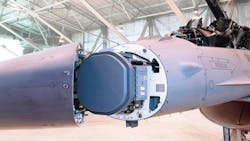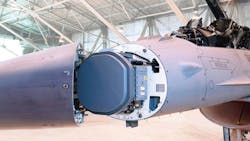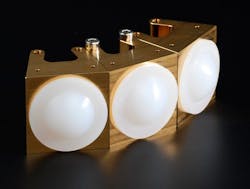This file type includes high resolution graphics and schematics.
Radar was once synonymous with the battlefield. And indeed, it still is an invaluable high-frequency technology for detection and warning of targets, whether installed on board ships, on aircraft, or in land-based systems. But RF/microwave radar technology is increasingly being applied in other markets, among them automotive, commercial, industrial, and even medical applications. Suppliers of key components, such as radar sensors, thus face the growing challenge of providing advanced technology devices at reduced costs to help spread radar technology to a greater number of market areas.
Related Articles • Cobra Judy Replacement Radars Pass Test • Source Serves FMCW Radar • MM-Wave Radar Guards AutomobilesAs military spending and strategies change with time, there is a greater tendency to rely on Intelligence, Surveillance, and Reconnaissance (ISR) systems onboard unmanned aerial vehicles (UAVs) or on satellites or ground-based systems. The large system suppliers—including Raytheon Co., Lockheed Martin, and Northrop Grumman—are still the leaders in military radar technology, and are constantly reviewing their capabilities in search of advances.
For example, the compact Raytheon Advanced Combat Radar (RACR) system (Fig. 1) is lightweight and scalable for use on a number of different aircraft, including on F-16 and F/A-18 fighter jets. It is based on the firm’s active electronically scanned array (AESA) technology and can be tailored to any aircraft’s size and weight, both for air-to-air and air-to-surface use. These electronically scanned radar systems allow pilots to acquire targets over greater distances and to track more targets simultaneously than radars with mechanically scanned antennas. In fact, the RACR with its AESA technology can conduct simultaneous air-to-air and air-to-ground missiles because of its advanced processing power.
1. The Raytheon Advanced Combat Radar (RACR) system employs AESA technology and a modular configuration to match with different-sized aircraft. (Photo courtesy of Raytheon Co.)
This trend toward smaller and lighter radar and surveillance systems is taken to new extremes by SpotterRF and its lines of man-portable radar systems. As detailed in the July 2012 issue of our Defense Electronics supplement, the company has assembled a portable Radar Backpack Kit (RBK) based on a pair of its M600C radar systems. These units, which are licensed by the US Federal Communications Commission (FCC) for use at X-band frequencies, boast a 3-minute setup time and a surveillance area as wide as 1000 x 800 m. Each radar module weighs about 4 lbs. and measures just 10.125 x 8.75 x 2.25 in.
The portable radar units draw only 10 W power from a voltage supply at +12 to +30 VDC. They are designed to be accurate at operating temperatures from -30 to +65°C and include an Ethernet interface for connection to a portable computer. The total weight of the RBK is less than 20 lbs. with two of the company’s M600C radars, a network hub tablet, a model 2590 battery, a tripod, and the cables needed for operation. Regardless of visibility or weather, the system can provide full 360-deg. coverage of an area greater than 150 acres.
For their part in promoting radar technology, several years ago MACOM Technology Solutions developed its Multifunction Phased Array Radar (MPAR) panel with the Massachusetts Institute of Technology for next-generation air-traffic-control (ATC) and weather surveillance applications. The MPAR system consolidates eight separate radar systems that are used for four functions: Terminal Air Surveillance, En-Route Air Surveillance, Weather Radar, and Terminal Doppler Radar. The MPAR system, which consists of multiple MPAR panels functioning coherently to transmit and receive radar pulses to detect, locate, and track both aircraft and weather, provides improved weather forecasting and reliable ATC capability.
Earlier this year, the firm also contributed to a major advance in solid-state power for radar applications by introducing a line of gallium nitride (GaN) in plastic packaged power transistors, featuring peak power levels to 100 W in plastic packages at microwave frequencies. Suitable for a new generation of commercial and military radar systems, these plastic-packaged transistors are supplied in miniature 3 x 6 mm dual-flat no leads (DFN) and standard small outline transistor (SOT-89) packages. They approach output levels of 100 W when operating at 10% duty cycle with a 1-ms pulse width and +50 VDC drain bias. The transistors are available for use from DC to 3.5 GHz and DC to 4.0 GHz.
This file type includes high resolution graphics and schematics.
Steering The Radar
This file type includes high resolution graphics and schematics.
The use of radar systems for automotive applications, notably for collision-avoidance chores, has been in planning since the late 1950s. Because of the high frequencies employed for automotive radar systems, however, commercialization of automotive radar—even for luxury car models—wasn’t feasible until the 1990s with the support of millimeter-wave semiconductors. With automotive radar systems focused largely at 24 and 77 GHz, advances in microcontrollers and RF/microwave integrated circuits (ICs) and monolithic microwave integrated circuits (MMICs) during the 1990s made the design and fabrication of high-frequency radar modules more practical for inclusion in commercial vehicles. Early automotive radar applications based on surround sensing technologies included parking-assistance systems, collision-warning, and adaptive-cruise-control (ACC) systems.
In 1992, commercial carrier Greyhound Bus took a lead in the use of traffic radar, installing forward-looking K-band (24-GHz) and side-looking X-band (10.525-GHz) radar systems with frequency-modulated-continuous-wave (FMCW) signals on about 1500 of its buses. The forward-looking radar systems employed phased-array antennas and about 0.5-mW transmit power for a detection range of about 350 ft. From 1992 to 1993, the firm reported a reduction of about 20% in accidents for the buses, although also struggled with operational problems caused by interference with the automotive radar from traffic radar signals.
In 1999, Mercedes introduced the 77-GHz “Distronic” radar system into its S-class vehicles, with other high-end automobile manufacturers (including Audi, BMW, Cadillac, and Jaguar) to follow. This ACC system helps maintain safe distances between vehicles. Japanese car manufacturers such as Honda and Toyota also applied brake-assist systems for collision mitigation applications based on 77-GHz long-range radar electronics. As a general trend, automotive radar systems are moving from driver/passenger comfort functions to more functions that serve both comfort and safety.
A number of organizations exist to assist in minimizing interference among automotive radar signals. The European Telecommunications Standards Institute established the 76 to 77 GHz frequency band for European automotive radar use in the 1990s by means of the ETSI EN 301 091 standard. The band is now allocated for Intelligent Transport Services (ITS) in Europe, North America, and Japan. As dictated by the FCC and the North American Free Trade Agreement (NAFTA), ultrawideband (UWB) technology in the range of 22 to 29 GHz is allocated for the North American market at a maximum mean power density of -41.3 dBm/MHz.
The short-range automotive radar frequency allocation consortium (SARA) was founded in the early 2000s to promote technology and UWB regulation for 24-GHz automotive radar in Europe. A range of 21.65 to 26.65 GHz was selected for UWB short-range automotive applications, with frequencies from 77 to 81 GHz for UWB short-range automotive use later added.
In addition to SRR sensors, several companies currently offer long-range-radar (LRR) sensors at 77 GHz. The ARS 300 radar sensor from A.D.C. Automotive Distance Control Systems GmbH uses FMCW signals to measure distance and velocity for collision-avoidance applications. The 77-GHz LRR3 long-range radar sensor from Bosch is based on silicon-germanium (SiGe) semiconductor technology and features a rugged mechanical design to withstand high vibration levels—most notably, when used in commercial trucks.
Medical Innovations
Radar technology has also captured the imagination of engineers working in medical applications, with medical radar systems applied to heartbeat and respiration monitoring, as well as for breast cancer detection. Both CW Doppler radar and pulsed UWB radar systems have been proposed for medical applications, for remote patient monitoring. For example, the Virtual Medical Assistant (VMA) from Sensiotec, Inc. employs UWB radar technology for remotely measuring patient heart and respiration rates and patient movement, without implants, electrodes, or sensors contacting the patient. The system, which acquires data every two seconds, works with a light-weight sensor panel that is placed within about five feet of a patient. It emits nanosecond UWB pulses that penetrate the body, with reflected signals from the torso, heart, and lungs detected, filtered, and processed to produce medical data on the patient’s body movement, respiration, and heartrate.
The patient data is readily available by wired or wireless networks to multiple care-givers, such as doctors and nurses, and special alerts can be programmed for patients with critical heart and respiratory rates. For caregivers, this can mean reduced monitoring costs and increased productivity. For patients, this type of medical radar technology represents freedom from wires and sensors, as well as the elimination of skin tears from adhesive-affixed sensors.
2. This W-band radar system uses a three-channel antenna with dielectric lenses to allow close-up monitoring of bodily functions in medical applications. (Photo courtesy of the Fraunhofer Institute.)
Researchers at the Fraunhofer Institute have developed a prototype radar system that works at millimeter-wave frequencies from 75 to 110 GHz. The W-band radar employs a three-channel antenna with dielectric lenses (Fig. 2); it is capable of penetrating all dielectric, nonmetallic, and nontransparent materials and identifying small objects with fine precision.The radar is suitable for a wide range of applications, from industrial monitoring to medical technology. The W-band system, which is about the size of a cigarette box, is a modular and cost-effective design. Based on gallium-arsenide (GaAs) semiconductors, its use of antennas with dielectric lenses allows it to capture data from objects both close as well as far from the antennas. Measured data can be transferred to a computer via Universal-Serial-Bus (USB) interface.
Bristol University spin-out Micrima (Bristol, UK) is developing a medical imaging system that can distinguish a breast tumor from normal tissue by detecting the difference between their dielectric properties. Micrima is applying pulsed radar technology to trying to find breast tumors. The firm’s multistatic array processing for radio-signal image acquisition (MARIA) technology is based on a multistatic radar.
Related Articles • Cobra Judy Replacement Radars Pass Test • Source Serves FMCW Radar • MM-Wave Radar Guards AutomobilesThe approach synthesizes an UWB pulse with a microwave vector network analyzer (VNA) sweeping in frequency from 4 to 10 GHz. The signal is transmitted from each element in a multiple antenna array and then received by all the other elements. The large aperture and wide bandwidth theoretically allow collection of reflected and scattered signals from objects as small as 1.7 mm. A three-dimensional image of the breast is constructed after the radar-return signals have been received. Transmitted signals have a peak power level of less than 1 mW, so the system is completely safe.
Since breast tumors can be distinguished from healthy breast tissue by differences in dielectric constant, the use of radio-frequency signals makes it possible to develop images for cancerous cells. The system, which is undergoing extensive clinical testing, was initially simulated by means of computer models before developing the experimental hardware. Micrima’s ultimate goal is to create a compact, low-cost version of the MARIA system that could be situated in surgeries and mobile screening units.
This file type includes high resolution graphics and schematics.
About the Author
Jack Browne
Technical Contributor
Jack Browne, Technical Contributor, has worked in technical publishing for over 30 years. He managed the content and production of three technical journals while at the American Institute of Physics, including Medical Physics and the Journal of Vacuum Science & Technology. He has been a Publisher and Editor for Penton Media, started the firm’s Wireless Symposium & Exhibition trade show in 1993, and currently serves as Technical Contributor for that company's Microwaves & RF magazine. Browne, who holds a BS in Mathematics from City College of New York and BA degrees in English and Philosophy from Fordham University, is a member of the IEEE.



